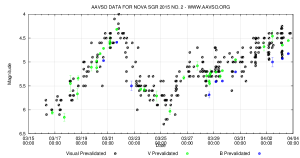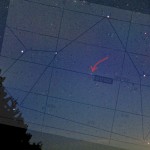- April, 3rd Location Munich Credit to Martin
- Nova Sagittarii Morgen Apr-7-2015_small
This “new” star is definitely worth to log. It was the brightest nova in Sagittarius (German Schütze) more than 100 years, and the brightest anywhere in the sky since Nova Centauri 2013.
Classical novae are not all alike. However, their underlying mechanism is the same: a white-dwarf star collects gas, mostly hydrogen, from a close companion star that’s overflowing its gravitational boundary. As the fresh hydrogen builds up on the white dwarf’s surface, the bottom of this layer becomes compressed by the dwarf’s powerful gravity.  Eventually the layer’s bottom becomes dense and hot enough to ignite in a runaway hydrogen-fusion reaction, which quickly spreads around the whole star — the layer becomes an H-bomb in the form of a thin shell. The brightness typically jumps by 10 magnitudes. The white dwarf eventually settles with the gas stream from its companion resumes, and the cycle begins anew. In a supernova, by contrast, an entire star explodes completely and for good.
Eventually the layer’s bottom becomes dense and hot enough to ignite in a runaway hydrogen-fusion reaction, which quickly spreads around the whole star — the layer becomes an H-bomb in the form of a thin shell. The brightness typically jumps by 10 magnitudes. The white dwarf eventually settles with the gas stream from its companion resumes, and the cycle begins anew. In a supernova, by contrast, an entire star explodes completely and for good.
For the picture a 50 mm lens is best:
| Length | FOV (Angles in degrees) | ||||||
| Format | 35mm & Full Sized e.g.Canon 5D | APS-C e.g. Canon 60Da | |||||
| Horizontal | Vertical | Diagonal | Horizontal | Vertical | Diagonal | ||
| 10mm | 122 | 100 | 130 | 99 | 76 | 109 | |
| 11mm | 117 | 95 | 126 | 94 | 71 | 104 | |
| 12mm | 113 | 90 | 122 | 89 | 66 | 99 | |
| 14mm | 104 | 81 | 114 | 80 | 58 | 90 | |
| 15mm | 100 | 77 | 111 | 76 | 55 | 86 | |
| 17mm | 93 | 70 | 104 | 69 | 49 | 79 | |
| 18mm | 90 | 67 | 101 | 66 | 47 | 76 | |
| 19mm | 87 | 65 | 97 | 63 | 45 | 73 | |
| 20mm | 84 | 62 | 95 | 61 | 43 | 70 | |
| 24mm | 74 | 53 | 84 | 52 | 36 | 61 | |
| 28mm | 66 | 46 | 75 | 45 | 31 | 53 | |
| 30mm | 62 | 44 | 72 | 43 | 29 | 50 | |
| 35mm | 54 | 38 | 63 | 37 | 25 | 44 | |
| 45mm | 44 | 30 | 51 | 29 | 20 | 35 | |
| 50mm | 40 | 27 | 47 | 26 | 18 | 31 | |
| 55mm | 36 | 25 | 43 | 24 | 16 | 29 | |
| 60mm | 33 | 23 | 40 | 22 | 15 | 26 | |
| 70mm | 29 | 20 | 34 | 19 | 13 | 23 | |
| 75mm | 27 | 18 | 32 | 18 | 12 | 21 | |
| 80mm | 25 | 17 | 30 | 17 | 11 | 20 | |
| 85mm | 24 | 16 | 29 | 16 | 11 | 19 | |
| 90mm | 23 | 15 | 27 | 15 | 10 | 18 | |
| 100mm | 20 | 14 | 24 | 13 | 9 | 16 | |
| 105mm | 20 | 13 | 23 | 13 | 9 | 15 | |
| 120mm | 17 | 11 | 20 | 11 | 7 | 13 | |
| 125mm | 16 | 11 | 20 | 11 | 7 | 13 | |
| 135mm | 15 | 10 | 18 | 10 | 7 | 12 | |
| 150mm | 14 | 9 | 16 | 9 | 6 | 11 | |
| 170mm | 12 | 8 | 15 | 8 | 5 | 10 | |
| 180mm | 11 | 8 | 14 | 7 | 5 | 9 | |
| 200mm | 10 | 7 | 12 | 7 | 5 | 8 | |
| 210mm | 10 | 7 | 12 | 6 | 4 | 8 | |
| 300mm | 7 | 5 | 8 | 5 | 3 | 5 | |
| 400mm | 5 | 3 | 6 | 3 | 2 | 4 | |
| 500mm | 4 | 3 | 5 | 3 | 2 | 3 | |
| 600mm | 3 | 2 | 4 | 2 | 2 | 3 | |
| 800mm | 3 | 2 | 3 | 2 | 1 | 2 | |
| 1000mm | 2.1 | 1.5 | 2 | 1.4 | 0.9 | 1 | |
| (1) 36x24mm 35mm film frame/FX sensor size – Field of View Crop Factor = 1 | |||||||
| (2) 23.6×15.7mm APS-C/DX sensor size – Crop factor = 1.5 | |||||||
| Formula: Field of View (in degrees) = Sensor size ÷ Focal Length X 57.3°The scale factor 57.3° is just 360° ÷ 2 pi. By the way this formula is likely less accurate for very short focal lengths. But let’s use my D60a camera and 940 mm telescope as an example, DPReview gives the sensor size as 22,3 mm × 14,9 mm. Use each dimension separately in the formula:
|
|||||||


